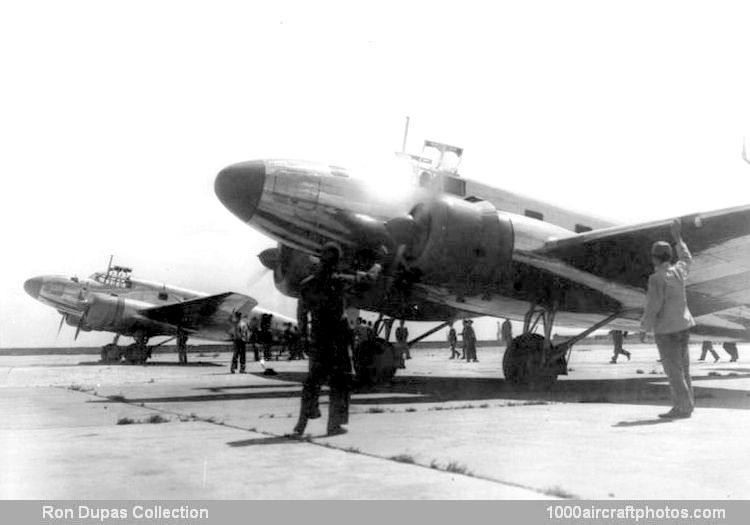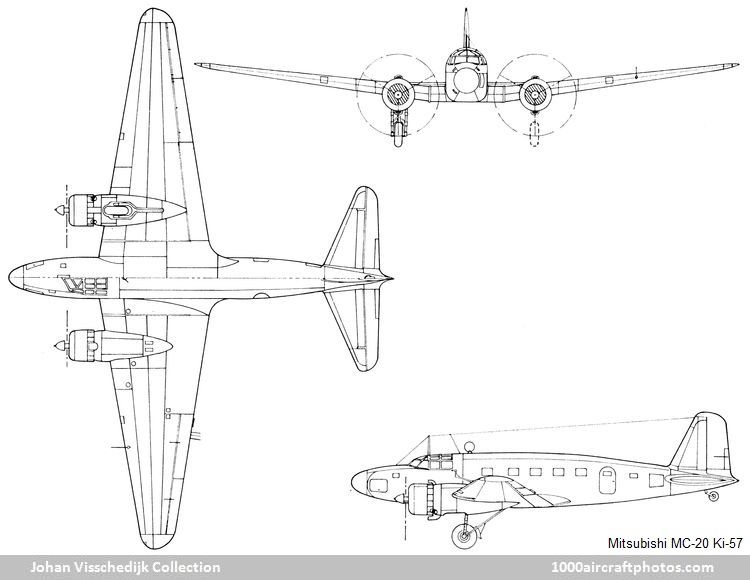05/15/2022. Remarks by Johan Visschedijk: "Standard personnel transport of the Imperial Japanese Army, the Ki-57 originated in early 1939 as a commercial transport developed by Mitsubishi from their Ki-21 heavy bomber at the request of Nippon Koku K.K. (Japan Air Lines). For service on their international routes the airline sought an aircraft of Japanese design with payload, speed and range performance similar to that of the military bomber. Preliminary design studies impressed the Army which had a requirement for a paratroop and staff transport and, when in August 1939 the airline was reorganized with government financial participation as Dai Nippon Koku K.K. (Greater Japan Air Line Co Ltd), the Koku Hombu issued to Mitsubishi a design specification covering the joint needs of the commercial airline and the military service.
Retaining the wings, tail and cockpit sections, landing gear and powerplant installation of the Ki-21-I, the transport aircraft, carrying the civil designation MC-20 and the military Kitai number Ki-57, featured a new fuselage accommodating-eleven passengers in two rows of single seats, and had its wings mounted low on the fuselage whereas its bomber forerunner had mid-mounted wings. Completed in July 1940 the prototype made its first flight in August, and by the end of the year, despite the loss of the fourth aircraft during a test flight off Chiba on Tokyo Bay, quantity production was authorized for both commercial and military use.
A total of 101 aircraft of the first production model were built by Mitsubishi between 1940 and 1942 and designated Army Type 100 Transport Model 1 (Ki-57-I) by the Army and MC-20-I by the civil authorities. A small number of Ki-57-1s were transferred to the Japanese Navy and designated Navy Type 0 Transport Model 11 or L4M1 by that Service.
Operated by the Army and Navy as a paratroop transport, communication and logistic support aircraft and by Dai Nippon Koku K.K. as a passenger transport on scheduled services as well as on military contract operations, the aircraft, named "Topsy" by the Allies, was met in all theatres of operation. Although most of the time the type performed unspectacular but necessary tasks, it earned its share of fame on February 14, 1942, during the Japanese paratroop attack on the aerodrome and oil refineries around Palembang.
In May 1942 an improved version of the aircraft, powered by two 1,080 hp Mitsubishi Ha-102 radials housed in redesigned nacelles and incorporating minor equipment changes, replaced the Ki-57-I on the assembly lines. A total of 406 of these aircraft were built for use by Dai Nippon Koku K.K. as the MC-20-II and by the Japanese Army as the Ki-57-II, Army Type 100 Transport Model 2. Plans to have the aircraft manufactured by Nippon Kokusai Kogyo K.K. failed to materialize and the last Ki-57-II was delivered by Mitsubishi in January 1945. After seeing active service throughout the war a few MC-20/Ki-57 aircraft survived and were operated under strict Allied control by Dai Nippon Koku K.K. until 10 October, 1945, when all Japanese air activities were prohibited."
No. 14086. Mitsubishi MC-20 Ki-57 Imperial Japanese Army Air Service
Photograph from USN, taken in Japan, September 1945
APS No. 293
APS No. 293


Created May 31, 2022